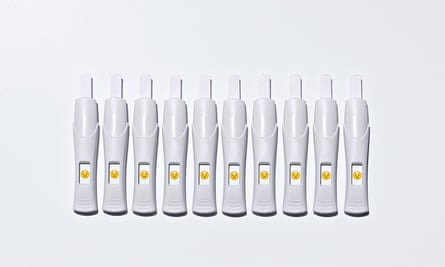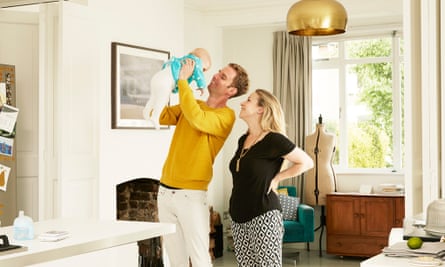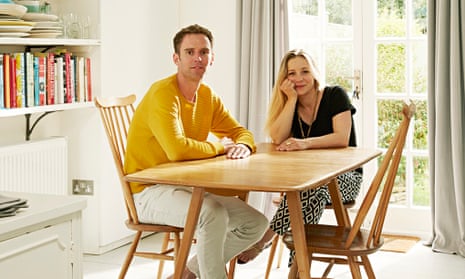The doctor shuffled the papers holding our test results. I had just had the first of what would turn out to be many internal ultrasound scans and was feeling shaken by the brutal indignity of it: the stirrups and the dildo-shaped scanner. “Well, it looks like everything is fine,” he said. “Oh. Ah. No.” He pulled out one of the papers. “No. It’s very unlikely you’ll be able to conceive naturally.”
When I was 28, five years and 48 crushingly regular periods ago, I suddenly and desperately wanted a baby. Two of my closest friends announced they were pregnant and there it was, sharp and inescapable: jealousy. I wanted one, too. It was impractical timing – I was newly and precariously self-employed and the house I rented with my partner, Steve, was tiny – but there was no chance I could be rational. It felt primal and urgent and strange.
Steve sensed that this wasn’t a negotiable issue, and over a curry one night, we agreed we would try to get pregnant. Few of our other friends had children yet, but that didn’t matter. We’d be pioneers, cool young parents. By the time the rest of them got round to it, we’d be nappy-changing, sling-wearing experts. We joked about how ironic it would be if we had trouble conceiving, given how much of my early 20s I’d spent worrying about getting pregnant. But we were young, and infertility was an older person’s problem, wasn’t it? That night, I cried happily into my dhal and assumed that within a year, two at the most, we’d be parents. Instead, here we were, sitting on the edge of a hospital bed, weeping, wearing hairnets and blue plastic shoe-protectors, while the doctor went off to check with the embryologists whether there was any point in trying for a few more months (there wasn’t).
The first six months of trying for a baby was a happy time. I obsessively Googled “early pregnancy signs” (hint: absolutely anything can be an early pregnancy sign, if you really want it to be, including, once, a tub of creme fraiche smelling off), and every month my period relentlessly returned. I bought books about understanding my body’s fertility signs, took my temperature before getting out of bed every morning, tracking it on a graph to see when I ovulated, or peed on tiny, expensive sticks that showed a less and less appropriate smiley face if the right hormones were present. None of these activities are aphrodisiacs.
Two years passed and nothing happened, at least not to us. We seemed to be surrounded by people who only needed to look at each other to get pregnant. Couples who hadn’t even met when we first started trying were already lapping us. Our closest friends all had babies; some even managed to have two.
From the outside, our life probably looked pretty charmed. I’m a food writer and Steve is a photographer. Our work was going well. We bought and renovated a house. We wrote and photographed two cookery books together. I started working as a presenter on Channel 4. We collected mid-century-modern furniture and argued over paint samples. I took up knitting and made quilts. But running like a thread through everything that was going right was a horrible absence. What was the point of working hard if there was no one to provide for? Why bother building a family home if we were just going to clatter about in it by ourselves?
I couldn’t help feeling like a failure. I had never experienced such a lack of control. Usually, through hard work and bloody-mindedness, I could force things to go my way. But you can’t work hard at being fertile.
Spending time with pregnant couples or their new babies became unbearable. Hardly anyone knew what we were going through; we didn’t tell our families and, while I told a few close friends at the beginning, it was several years before Steve confided in anyone. Guiltily at first, then, as time passed, bitterly, I stopped sending baby cards and gifts. Baby showers, once silly but sweet affairs, left me bruised: there’s nothing better than a few rounds of pin-the-sperm-on-the-uterus in a room full of baby bumps to make the childless feel bereft. At a Christmas party, two sisters announced they were due to have babies in the same week, and that one was having twins. I locked myself in the bathroom, cried, and then got very drunk, ignoring my friends and instead hanging out with other, much younger, child-free guests.
I have three close girlfriends, who all had daughters within a year of each other. As any proud parent would, they sent me photos regularly; unforgivably, I asked one to tell the others to stop. If babies came up in conversation, often I would simply leave the room. Later, friends admitted that they mistook our distance for disdain. “We just thought you hated children,” said one. Others assumed I’d chosen my career over a family.

Infertility is a deeply private experience, something most of us wrangling with never discuss. Fertility, on the other hand, is not. “Do you think you’ll ever have a baby?” “You two should hurry up and have kids.” “Best thing I ever did.” “I know what you career women are like.” I was in my 30s by then, and most weeks a client, friend or relative would ask me when we were planning to have kids, or remind me not to leave it too late. Kudos to my friend Sam, who, when her great aunt told her that at 33 she should be trying harder, said, “I’ve had four rounds of IVF and an ectopic pregnancy. How much harder do you think I can try?”
Nobody forgets to have children. It’s usually either a positive choice or there’s a raw and painful battle dragging on behind the scenes. It wasn’t something I wanted to discuss just before a meeting, in a bar, or at some distant relative’s wedding anniversary. Whenever anyone asked if I wanted a baby, I’d say, “Oh, I couldn’t eat a whole one,” and laugh like a crazed hyena.
I know that what I’m saying smacks of cognitive dissonance. I want infertility to be more openly discussed. But I couldn’t have talked about it when it was happening to me. Back then, what I really wanted, apart from two blue lines to appear on a little white stick, was for people I barely knew to stop treating the question of whether I would ever manage to have a child as small talk, akin to chatting about the weather.
The latest data from the UK’s Human Fertilisation and Embryology Authority (HFEA) suggests that two-thirds of women who have IVF treatment in the UK are under 37. The most quoted statistic – the one that makes women in their early 30s unnecessarily nervous – is that their average age is 35, as though our ovaries all spontaneously combust as that birthday approaches. In fact, just under 44% of women who have IVF are aged between 18 and 34. The idea that only older women need IVF is out of date, too – less than 20% are over 40. I was 31 when we discovered we’d need treatment; Steve was 32.
About one in seven couples is unable to conceive naturally within two years. It’s highly likely that you know couples who have struggled, or had some kind of treatment, even if they never tell anyone. Nearly a quarter of a million babies have been born in the UK as a result of IVF since 1991. Now, they account for 2.2% of all births annually.
In about 30% of cases, the man is the cause of a couple’s infertility. Steve’s sperm and my blood had been tested and cleared by our GP, but because our infertility was still unexplained, we were referred for tests at a clinic. My ovaries and fallopian tubes were checked for cysts and blockages, and more sophisticated checks were done on Steve. As his sperm count and motility were fine, we both expected that the problem was with me; most people assume that infertility is a primarily female problem.
We were wrong. Steve has anti-sperm antibodies. At some point in his life, the usually impermeable barrier between his semen and his blood supply had been broken, perhaps by a sports injury or during an illness such as mumps, and his body started to attack his sperm as though it were an invader, making it practically impossible for us to conceive. Estimates vary, but as many as 10% of men may have anti-sperm antibodies. It’s impossible to know for sure, because they don’t always result in infertility, and the effects depend on the type of antibody and their severity. About 1% of women produce antibodies which attack sperm.
The only option for us was intra-cytoplasmic sperm injection (ICSI), a more complex version of IVF. Standard IVF means an embryologist mixes harvested eggs and sperm and leaves them alone to allow fertilisation to occur. When ICSI is used, an embryologist injects a single sperm into an egg; about half of all IVF treatments involve ICSI.
We were lucky in that we qualified for NHS funding: our borough would pay for one round of IVF and two frozen transfers, if we had any leftover embryos. Despite clear guidance from the National Institute For Health And Care Excellence, whether patients get funding or not is a postcode lottery. Because the cause of their infertility isn’t clear enough, my friends Steph and Jake are paying for private treatment. They would qualify for funding if they lived 400 metres farther down their road and were under the care of their neighbouring NHS trust.
We waited a long, sad year between finding out our situation and starting treatment. By the time we got our referral, we were in the middle of moving house and Steve sensibly insisted that we didn’t try to do both at once. We grew up together and are incredibly close, but sometimes during that year it felt like a channel was opening up between us. My need to be a parent had expanded to fill all my thoughts, all the time, but for Steve, the years had allowed him time to question whether he wanted children at all. Isolated from our friends, and now, increasingly, from each other, we were both lonely. We never talked about what would happen to us if IVF didn’t work, or what else we might try, because it simply had to work.
Fertility clinics are strange places. While you are a patient, they become the hushed, sterile centre of your universe. Then, as soon as you’re discharged, you try to forget you were ever there. There was abstract art on the walls of our waiting room, patterns made up of disconcertingly large eggs and sperm, and a noticeboard covered in photos of the babies the staff had helped create. Whether cheerful or tragic, every waiting-room conversation was whispered; like any waiting room in Britain, no one met anyone else’s eye. One day, surreally, a harpist arrived, unannounced and unexplained, and started playing. He couldn’t turn off the television, so BBC News 24 babbled on in the background.
Before we could begin treatment, we were invited to an open evening for new patients. Incongruously, it took place in the teaching hospital’s large, tiered lecture theatre; there were hundreds of us, lined up in anxious rows, like barren students. While the nurses and doctors explained what was about to happen to us all, I scribbled pointless notes about success rates (30-40%) and looked around the room: how many of us would this work for? How much time, energy and, later, money, would we have to throw at having a family, something which comes so easily to so many people?
Finally, in February last year, I began injecting myself in the stomach with hormones so that the clinic could take control of my cycle. I congratulated myself on handling the injections rather well, until I thought I was having an allergic reaction to a new drug and made Steve ring an ambulance. I was actually having a panic attack, but still they gave me an ECG while I lay, horrified by my own hysteria, in my pyjamas on the kitchen floor. Every day or two, I’d go back to the hospital and my blood would be checked and the doses tweaked, until my ovaries had produced enough eggs for collection. On a cold and sunny spring morning, I was given a general anaesthetic and the eggs were collected using a long, thin needle. Before I was put under, Steve and I made polite conversation about the landmarks we could see from the high hospital windows, both of us ignoring the incomprehensible thing we were about to do: give little bits of ourselves to a scientist, who was going to try to make these bits into a person. When I came round, slurring my words, I kept asking how long I’d been gone, thinking that longer meant more eggs. More than 20 had been collected and were on their way to the lab. When we were discharged I had to sign a piece of paper promising I wouldn’t use a kettle for 24 hours.
Over the next few days the numbers kept dropping. Sixteen eggs were viable. Eleven had fertilised. Seven survived the first few days. A couple had made it as far as blastocyst stage by day five, meaning they were the most likely to result in pregnancy. When we were called in for the embryo transfer, when the doctors would shoot the microscopic blastocyst up a tiny tube into my uterus, my overwhelming feeling wasn’t fear or excitement but of desperately needing the loo. The transfer has to be done with a full bladder, and during a trial run a few weeks before, I’d been told off for not drinking enough beforehand. This time, I’d gone completely overboard and nearly peed all over the operating table. Unexpectedly, the doctor asked if we would like one or two embryos put back, and we suddenly had to decide if we wanted twins or not. (Multiple pregnancies are more dangerous for both babies and mothers, and HFEA has set limits on how many of them a clinic should risk.) We opted for one. The nurse did well not to laugh when I asked if it was all right to go to the loo afterwards, wanting to check that it wouldn’t fall out.
It would be another 18 days before we could do a test. We spent the time in a kind of limbo. Though I knew I was unlikely to be pregnant, I had to treat my body as though I was, while the synthetic hormones I had taken ebbed and flowed away, making me feel sick, sore and exhausted. On the day of the test, I was awake and staring at the ceiling at 5am. Steve rolled over. “Do you want to do it now?” I was crying before I even got to the bathroom and ripped the wrapper off, wondering if I could manage, physically and mentally, to repeat the last weeks again, and perhaps again and again. Steve said he could tell the result before I got back to our room by how fast I was moving – skittering instead of the slow walk and quiet “no” that had soundtracked every test so far.

After four years and more than 40 negative tests, we finally got a positive one. The IVF treatment had worked, first round, first time. Three weeks after that we got to see a heartbeat on a screen and took home a photograph of a tiny, peanut-shaped glimmer of a person. Our daughter, Isla, was born in December. She has six potential siblings safely locked in a freezer somewhere – a fact which is as difficult to accept as it is that Isla, beautiful and chubby as she is, began life under a microscope.
Steve was relieved to feel instantly euphoric; like me, he fell in love with Isla the moment she appeared. Mothering after IVF brings with it specific challenges: the first few weeks are startlingly hard for all new parents, but if you’ve been waiting half a decade to achieve what I expected to be a state of bliss, the reality can seem shockingly painful at first. I’ve never experienced anything as relentless as having a newborn baby. But then, I’ve never been so happy, either .

Comments (…)
Sign in or create your Guardian account to join the discussion